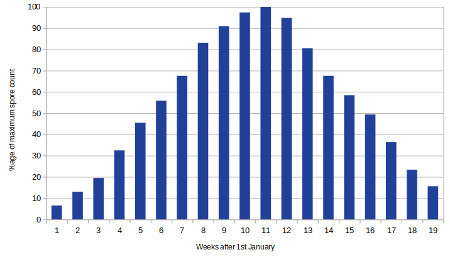
Farm Tours
We offer farm tours for smaller groups and families to meet, feed, interact with and walk with our alpacas.
For full details and to book your experience of these wonderful animals, please go to our reservation form.
Unfortunately there are many livestock owners in New Zealand and around the world who have experienced this serious disease as it affects sheep, cattle, red deer, goats and especially camelids. The financial loss to NZ farmers alone is an estimated $NZ332 million annually in lost production.
The disease is caused by a toxin contained in the spores of the fungus Pithomyces chartarum. Although known worldwide, facial eczema is especially common in New Zealand due to the high percentage of toxin producing P. chartarum strains as compared to other countries. Alpacas are more sensitive than sheep to this disease, likely due to the probable absence of any selection pressure in their native environment.
After several days of warm humid weather with night time temperatures of over 13°C, especially with rain, heavy dews or high relative humidity, the fungus begins growing on the decaying leaves at the bottom of the grass sward [22]. When eaten, the fungal spores release the mycotoxin sporidesmin into the gut which causes severe liver and bile duct damage. Obstruction of the bile duct may also occur which restricts excretion of bile pigments. This results in jaundice and an inability to excrete the waste product phylloerythrin (from chlorophyll breakdown), leading to photo-sensitization of the skin [4]. Severe skin irritation follows which the animal tries to relieve by persistent rubbing of its head against objects (e.g. fences, trees, etc.). This causes swelling and peeling of the skin, especially around the eyes and on the jaw and ears. There may also be restlessness, frequent urination, shaking, drooping ears, swollen eyes and the seeking of shade to avoid sunlight. Unfortunately, by the time these symptoms are seen, damage to the liver has already occurred. Note that some of the symptoms listed may be missed as they can be subtle and sudden death occurs. Veterinary assistance is absolutely essential in assessing and treating affected animals. An initial diagnosis is made based on these symptoms and behaviours but confirmation requires blood testing for γ-glutamyltransferase (GGT) levels.
Sporidesmin often causes permanent liver damage so supportive care is needed for any affected alpaca. They should be kept in the darkest area available and receive pain relief, vitamins for liver support and low protein feeds until there is recovery. The liver of any animal affected will regenerate but it will never function effectively again. The animal is therefore at increased risk during the next FE season. A further consequence is that a pregnant female with severe liver damage may die soon after unpacking as the liver of her foetus had been supporting her. The consumption of spores causes potentiation and consuming small quantities of spores at a later date can lead to a severe outbreak. In sheep, sub-clinically affected ewes may have reduced fertility and fecundity and will often lose condition in late pregnancy. Although not reported, it is likely that alpacas will show the same pattern.
Spore numbers in the grass swards indicate how toxic it will be if eaten and so spore counting is a reliable indicator. There are many commercial and local veterinary services available for determining spore counts in samples taken from paddocks. A number of videos are available online showing methods for taking samples. These sample bags should be taken to a veterinary practice or farm supply business for sending to the testing laboratory. Other local area spore counts may also be available there. Aggregated counts for areas nationwide can be viewed on the Gribbles Veterinary website and also show previous facial eczema seasons. The graphs shown after accessing the lab-portal are real-time and indicate the percentage of received counts above the 30,000 spores/gram of material. Counts in excess of 30,000 spores/g sample are regarded as hazardous to all stock.
Protecting your alpacas from these fungal spores cannot be overemphasised. There are three main elements to achieving this as shown in the panel.The image below shows an example curve for spore counts over the facial eczema season. The height of the spore counts is usually in March/April though the magnitude and exact timing will vary with seasonal conditions. It should be noted that spore counts are highly variable between farms in the same vicinity, between paddocks at the same farm and even within a paddock. Effectively, this means that local spore counts can be taken as a guide but alpaca owners must correctly time their protective measures to ensure the health of their animals.

In New Zealand, the facial eczema season usually starts in early January. Given that it takes about two weeks for the blood zinc levels to rise to a protective state, the feeding of zinc-containing nuts should begin at New Year. Much depends on the weather in your area because if the ground is very dry and there is not likely to be any rain in the next week of so, starting dosing may be delayed. Long range weather forecasts can help here.
Introduction of the zinc kibble should be gradual - initially adding some to normal alpaca nuts and steadily increasing the proportion added over 7-10 days until the correct level is reached. Supplementation with 2g of elemental zinc per 100kg live weight per day is recommended by the feed manufacturers and scientific literature. Provided here is a calculator to work out how much should be fed to an alpaca of a given weight. This assumes kibble being fed which contains 8g of supplemental zinc per kilo.
From observations in other ruminant species, excessive consumption of zinc for extended periods of time is known to lead to mild pancreatitis and copper deficiency. Because of this, a maximum period of 100 days is recommended for sheep and cattle. Unfortunately, there are no studies with alpacas into this dosing period so rightly or wrongly, the same recommendation has been followed. It can be seen from the graph that the 100 days of dosing expires during April when spore counts are still elevated so most owners extend this period. The onset and severity of the facial eczema seasons vary so having grass samples tested and keeping a close watch on spore counts is essential.
Please note that the peak of spore production during the FE season can be at any time in the 16 week risk period. In 2021 there were in fact two peaks (in weeks 9 and 14) whereas 2022 peaked only in week 6. In particularly bad FE years, an extended period of dosing with zinc pellets and feed supplementation will be needed - the reversible side-effects of copper deficiency and mild pancreatitis are a far better outcomes for the alpaca when compared with death through liver failure.
Most of the literature below can be accessed by clicking on the highlighted link. Some links will access the appropriate web page from which the article can be downloaded but others will immediately start downloading the full reference.
4. Boyd, E. (2016). Management of Facial Eczema. M.Vet. Stud., Massey University.
21. Sinclair, D.P. and Howe, M.W. (1967). Effect of thiabendazole on Pithomyces chartarum (Berk. & Curt.) M. B. Ellis. N.Z. J. Ag. Res., 11(1): 59-62. DOI: https://doi.org/10.1080/00288233.1968.10431634
22. Mitchell, K. J., Thomas, R. G. and Clarke, R. T. J. (1961). Factors influencing the growth of Pithomyces chartarum in pasture. N.Z. J. Ag. Res., 4(5-6): 566-577. DOI: 10.1080/00288233.1961.10431614